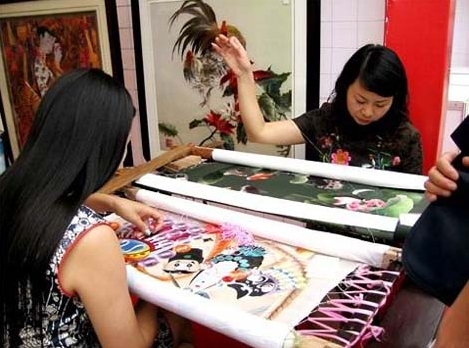
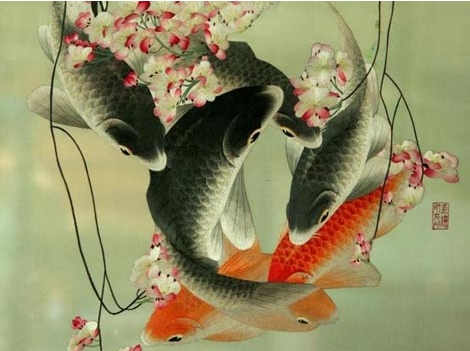

Sichuan embroidery is an ancient handicraft handed down from more than 2,000 years ago in Sichuan Province, which is known as "the Land of Abundance."
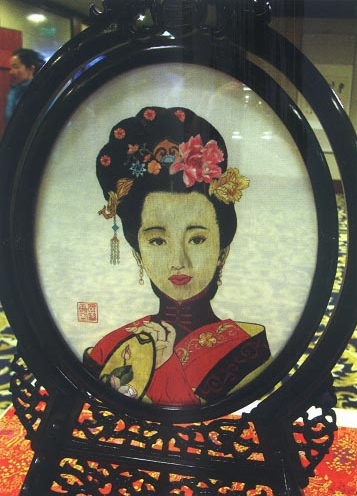
A piece of double- faced embroidery made by Ms. Kang Ning, a master of Sichuan style embroidery
Since ancient times, Sichuan has had beautiful landscapes and plentiful products. The people have developed a folk art, Sichuan embroidery, which includes pastel shades and an elegant, exquisite and carefree style.
Sichuan embroidery is one of China's four most famous branches of embroidery, the others being Jiangsu, Hunan and Guangdong. Having formed its unique graceful bearing with its bright, clear colors and the style of Chinese-ink paintings, Sichuan embroidery has been honored as being "an art jewel of the Orient."
The embroidery is mainly produced in Chengdu, Chongqing, Wenjiang and Pixian and has a long history. The imperial government of the Han Dynasty set up an office in Chengdu to manage it. By the Song Dynasty, Sichuan embroidery made fast progress and was becoming more refined each day. A hanging scroll of Sichuan embroidery during this time, which exists to this day, is very exquisite and refined. Already, specialized production of Sichuan embroidery had developed in the Qing Dynasty. In Chengdu City many embroidery shops, where great painters and embroidery masters assembled, exquisite embroidery was being produced in large numbers, and Sichuan embroidery was honored as being "objects without equals in the world."
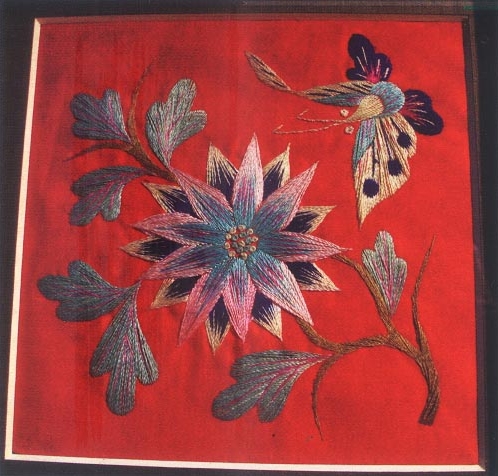
A peice of Sichuan embroidery made in the Qing Dynasty
Silk has been produced in Sichuan Province in abundance since ancient times and Chengdu was the starting point of the southern Silk Road. Sichuan embroidery is produced with local silk, satin and colored silk threads as the raw materials, and special embroidery skills are used to make quilt covers, pillowcases, clothes, shoes and painting scrolls.
Learning Sichuan-style embroidery is difficult because the stitching and skills are special and complex. In the stitching methods alone, there are 12 categories and 132 varieties, the richest among the four most famous schools of embroidery in China. Alternating stitching methods results in numerous combinations, and different stitching skills result in subtle degrees of expression and effect and each stitch is impeccable. In Hibiscus with Carp, a famous traditional product in Sichuan embroidery, more than 30 stitching methods are needed for just one carp. In addition are other unique skills. Take "double-faced embroidery in varied colors" for instance; it is necessary to operate two embroidery needles at the same time and no error is allowed in the direction, sequence and strength of the thread. If one stitch is out of place it is highly likely that the whole embroidery may be destroyed.

An Idle Dream, a piece of Sichuan style embroidery
The subjects of the embroidery are rich and varied: some come from dramas and short stories, such as Mu Guiying the Woman General, Eight Immortals Crossing the Ocean, and Chinese Unicorn, Which Gives Out Children to Those in Want of Them, and others come from "Mandarin Ducks Playing with Water," which depicts human love, "Phoenix with Peony," which depicts fortune, and "Pines Cypresses and Red Crowned Cranes," which indicates longevity.
The development of Sichuan embroidery has been often strongly supported by painters. In ancient China, some outstanding landscape painters provided a lot of subject-matter, such as the bamboos and stones painted by Zheng Banqiao, and the jagged rocks of grotesque shapes by Su dongpo. A major distinguishing feature of Sichuan embroidery is that talented painters and skilled embroiderers joined hands in presenting rare treasures of Sichuan embroidery. The embroidered screen by the name of Xue Tao Making Writing Paper is a fine work processed by embroidery masters with a design provided by famous painter Zhao Yunyu (1916-2003).
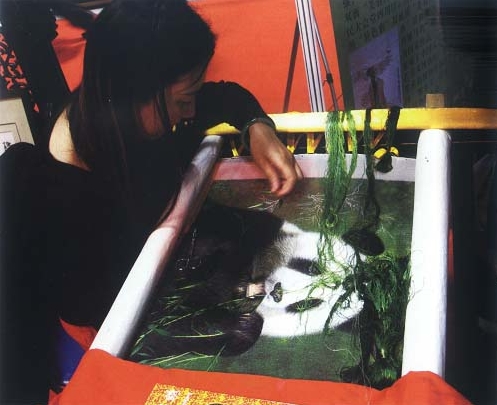
Embroidering a giant panda
Double-faced embroidery with designs of different colors and different shapes has a high degree of difficulty. For example, the embroidered screen named Zuo Wenjun Listening to Zither depicts the famous love story between Zhuo Wenjun, a widow, and Sima Xiangru (179-117 BC), a famous writer. The reverse side shows Zhuo Wenjun listening to a zither outside a curtain, while the player Sima Xiangru appears on the other side of the screen, playing the instrument behind the curtain. The two sides mesh perfectly into a complete story. The double-sided embroidery Puzzle by Ms. Kang Ning, a noted artist of Sichuan embroidery, is also a masterpiece. One side shows a beautiful lady in ancient costume and on the reverse is a skeleton. Ms. Kang worked for more than a year to complete the embroidery and used more than 100.000 stitches.
Sichuan embroidery now under production consists mainly of objects of appreciation. The most famous are "Carp," "Pandas," "Ladies" and "Grapes." Most articles are gems of close cooperation between traditional Chinese painters and master embroidery artists. For instance, Su Baozhen is a famous painter of traditional Chinese paintings and Hu Huiqin is a master embroidery artist with 43 years'experience. The embroidery Rich Fruit by Hu Huiqin draws its subject-matter from the painting Grapes in Basket by Su Baozhen. She has used more than a dozen stitching methods in the embroidery. Viewed from different angles, every single aspect of the clusters of grapes in the embroidered screen radiates a bright and splendid luster.
Sichuan embroidery is a folk handicraft applied in quilt covers and pillowcases for everyday use and picture screens for appreciation. However, considering its numerous stitching methods, difficult level of high skill and beautiful appearance, few people are willing to subject the exquisite artwork to practical use. After all, this handicraft had been considered "a treasure of Sichuan" as far back as the Jin Dynasty (265-420).





